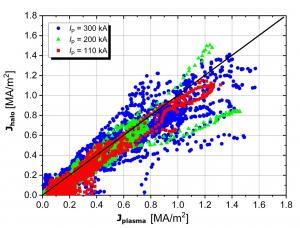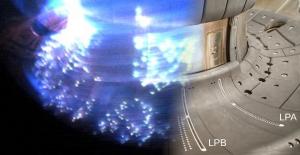Understanding current flow during plasma disruptions
Scientists from the COMPASS tokamak at the Czech Academy of Sciences in Prague and the ITER Organization have performed a set of experiments to improve the understanding of plasma disruptions. This joint effort has provided the first experimental evidence of a physical limit to the flow of electric currents between the plasma and tokamak components during these events. This finding will help scientists to refine models and provide improved predictions of plasma dynamics and the associated forces on in-vessel components during ITER disruptions.
In tokamaks, disruptions are sudden losses of the thermal and magnetic energy stored within the plasma, which occur when operating near plasma stability limits or when systems malfunction and plasma control is lost. Disruptions, particularly on large devices like ITER, can lead to high power fluxes and mechanical forces on in-vessel components, which can impact their lifetime. A major contributor to these loads are the electric currents that circulate between the plasma and the components during the "current quench" phase of the disruption when the plasma current collapses. The amplitude and distribution of these electric currents (the so-called halo currents), together with the strong magnetic fields always present in tokamaks, determine the local mechanical stresses on the in-vessel components and thus need to be understood in detail to refine expectations for ITER.
Physicists from the Institute of Plasma Physics in Prague working on the COMPASS tokamak and from the ITER Organization have collaborated to perform a series of careful experiments designed to measure the halo currents circulating between the plasma and surrounding components during disruption current quenches. The result is a unique database of high spatial resolution measurements of these currents.
The experiments, reported in this recent publication, have demonstrated (Figure 1) that the local value of the halo current cannot exceed the local value of the plasma particle flux to the in-vessel components. This physics limit, already known for decades to apply under standard plasma conditions in the cool plasma edge where magnetic field lines intersect solid surfaces, has been found on COMPASS during these extremely transient disruptive phases using arrays of dozens of tiny, finely spaced electric sensors known as Langmuir probes embedded in the divertor target surfaces (see LPA and LPB in Figure 2). This probe system captured the halo and the plasma flux simultaneously for the first time during purposely triggered disruptions. The experiments also confirmed previous findings elsewhere that the global value of the halo current is proportional to that of the current flowing in the plasma before the disruption. This, together with the new limit identified in these experiments, means that the area of in-vessel components over which the halo current flows grows with increasing current when the limit is at work. This spreads the halo current across the in-vessel components and lowers the local stresses compared to what would be predicted if such a limit were not applied.
To improve predictions of plasma behaviour during disruptions, complex simulations are performed for ITER. These COMPASS results have already shown that inclusion of the newly identified halo current limitation in the simulation of disruptions is essential to reproduce plasma behaviour observed on COMPASS itself, as reported in a related publication. To consolidate predictions for ITER disruptions, it is important to experimentally determine the role that the newly identified limit plays on the dynamics of disruptions across other tokamaks operating within the ITER Members' R&D institutions and to reproduce the observations using the simulation codes applied to model ITER. This will allow to both better understand and predict the loads expected during disruptions in ITER and to optimize their mitigation by the sophisticated disruption mitigation system being prepared for ITER.



